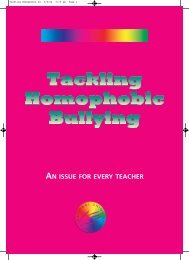Non-Normative Gender and Sexual Identities in Schools: - Schools Out
Non-Normative Gender and Sexual Identities in Schools: - Schools Out
Non-Normative Gender and Sexual Identities in Schools: - Schools Out
You also want an ePaper? Increase the reach of your titles
YUMPU automatically turns print PDFs into web optimized ePapers that Google loves.
Tackl<strong>in</strong>g Homophobia A4 3/6/04 5:15 pm Page 3<br />
Effects of Homophobic Bully<strong>in</strong>g<br />
Research shows l<strong>in</strong>ks between homophobic<br />
bully<strong>in</strong>g <strong>in</strong> schools, truancy <strong>and</strong> educational under<br />
achievement. Homophobic bully<strong>in</strong>g impacts upon<br />
the health, emotional well be<strong>in</strong>g <strong>and</strong> academic<br />
atta<strong>in</strong>ment of young people subjected to such<br />
bully<strong>in</strong>g.<br />
A research study <strong>in</strong> 2000 found that 72 per cent of<br />
victims of homophobic bully<strong>in</strong>g have a history of<br />
truancy <strong>and</strong> that the majority of victims of<br />
homophobic bully<strong>in</strong>g with a history of truancy<br />
leave school at age sixteen, regardless of academic<br />
qualifications.<br />
Further research <strong>in</strong> 2001 which explored the long<br />
term effects of homophobic bully<strong>in</strong>g on emotional<br />
health <strong>and</strong> well be<strong>in</strong>g found that of those LGB<br />
adults who had been bullied at school over half<br />
had contemplated self harm or suicide.<br />
All forms of bully<strong>in</strong>g, <strong>in</strong>clud<strong>in</strong>g homophobic bully<strong>in</strong>g,<br />
need to be identified <strong>and</strong> tackled. It has taken some<br />
time for homophobic bully<strong>in</strong>g to become recognised<br />
as an issue <strong>in</strong> schools. There is an urgent need to<br />
tackle bully<strong>in</strong>g relat<strong>in</strong>g to sexual orientation <strong>in</strong><br />
schools. There is evidence to show that susta<strong>in</strong>ed<br />
anti-bully<strong>in</strong>g <strong>in</strong>itiatives can decrease bully<strong>in</strong>g.<br />
It takes courage for students to approach teachers<br />
for help when they are be<strong>in</strong>g bullied. This is<br />
especially true for those subjected to homophobic<br />
bully<strong>in</strong>g. Anxiety can lead to self-harm, violence<br />
towards others, substance abuse or even suicide.<br />
Some seek pregnancy or fatherhood.<br />
Children who do not feel safe with<strong>in</strong> an<br />
educational <strong>in</strong>stitution do not perform to the best<br />
of their ability. Those who are bullied commonly<br />
lack confidence, concentration <strong>and</strong> motivation.<br />
Such pressures are likely to impact negatively on<br />
their academic performance. Children truant<strong>in</strong>g or<br />
refus<strong>in</strong>g to attend school often cite bully<strong>in</strong>g as a<br />
factor <strong>in</strong> this behaviour.<br />
● the <strong>in</strong>clusion of curriculum resources <strong>in</strong> the<br />
school library that are relevant <strong>and</strong> appropriate<br />
for school age pupils;<br />
● a commitment to work on homophobia with<strong>in</strong><br />
the PSHE (or PSE curriculum <strong>in</strong> Wales) <strong>and</strong> SRE<br />
curriculum <strong>and</strong> citizenship frameworks;<br />
● the development of l<strong>in</strong>ks with outside agencies<br />
to offer expertise to schools <strong>and</strong> to offer advice<br />
<strong>and</strong> support to students experienc<strong>in</strong>g issues<br />
around their develop<strong>in</strong>g sexuality;<br />
● work on solutions to reduce the homophobic<br />
content of commonly used terms of verbal abuse<br />
<strong>and</strong> challenge negative stereotypes;<br />
● proper supervision of the school site, <strong>in</strong>clud<strong>in</strong>g<br />
attention to areas where pupils may be<br />
vulnerable;<br />
● procedures to achieve <strong>and</strong> monitor systems to<br />
provide a consistent experience <strong>in</strong> terms of<br />
responses to homophobic bully<strong>in</strong>g behaviour<br />
<strong>and</strong> teacher reactions to <strong>in</strong>dividuals, situations<br />
or <strong>in</strong>cidents;<br />
● the collection <strong>and</strong> analysis of <strong>in</strong>formation on the<br />
<strong>in</strong>cidence of bully<strong>in</strong>g, tak<strong>in</strong>g full account of the<br />
views of the pupil;<br />
● check<strong>in</strong>g that follow-up action on confirmed<br />
allegations of bully<strong>in</strong>g is appropriate <strong>in</strong> its range<br />
<strong>and</strong> is susta<strong>in</strong>ed;<br />
● the use of positive peer pressure <strong>and</strong> the<br />
<strong>in</strong>volvement of pupils <strong>in</strong> befriend<strong>in</strong>g <strong>and</strong><br />
mentor<strong>in</strong>g schemes;<br />
● the use of LEA professionals to work alongside<br />
teachers, pupils <strong>and</strong> parents <strong>in</strong> overcom<strong>in</strong>g the<br />
extreme effects of bully<strong>in</strong>g; <strong>and</strong><br />
● l<strong>in</strong>ks between all forms of discrim<strong>in</strong>ation<br />
<strong>in</strong>clud<strong>in</strong>g racist, sexist, disablist, homophobic<br />
<strong>and</strong> transphobic behaviour.<br />
Practical Strategies<br />
Strategies available for address<strong>in</strong>g homophobic<br />
bully<strong>in</strong>g <strong>in</strong>clude:<br />
● an explicit reference <strong>in</strong> the school’s anti-bully<strong>in</strong>g<br />
strategy <strong>and</strong> equal opportunities policies to<br />
strategies to prevent homophobic bully<strong>in</strong>g;<br />
● the development of a school-wide <strong>in</strong>itiative to<br />
challenge the use of offensive <strong>and</strong> homophobic<br />
language;<br />
● the removal of graffiti;<br />
● the commitment of staff INSET time to build<strong>in</strong>g<br />
staff confidence <strong>in</strong> tackl<strong>in</strong>g homophobia <strong>and</strong><br />
the provision of practical tra<strong>in</strong><strong>in</strong>g around<br />
challeng<strong>in</strong>g homophobic bully<strong>in</strong>g behaviour;<br />
DfES Guidance<br />
LEAs have specific duties to tackle bully<strong>in</strong>g. <strong>Schools</strong><br />
are required to have discipl<strong>in</strong>e policies that <strong>in</strong>volve<br />
address<strong>in</strong>g bully<strong>in</strong>g. LEAs are required to ensure<br />
that schools comply with their duties.<br />
The NUT welcomed the DfES guidance ‘Don’t<br />
Suffer <strong>in</strong> Silence’ , which provides <strong>in</strong>formation <strong>and</strong><br />
practical advice on steps schools can take to<br />
combat bully<strong>in</strong>g. The DfES advises that a school<br />
policy on bully<strong>in</strong>g “should be short, succ<strong>in</strong>ct <strong>and</strong><br />
written <strong>in</strong> a language that everyone underst<strong>and</strong>s”<br />
<strong>and</strong> <strong>in</strong>clude a def<strong>in</strong>ition of bully<strong>in</strong>g which <strong>in</strong>cludes<br />
“racist, sexist <strong>and</strong> homophobic bully<strong>in</strong>g”.<br />
The DfES guidance makes the po<strong>in</strong>t that pupils do<br />
not necessarily have to be lesbian, gay or bisexual<br />
2







